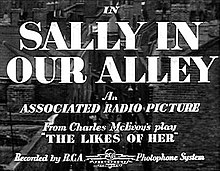fiction.wikisort.org - Movie
Sally in Our Alley is a 1931 British romantic comedy drama film directed by Maurice Elvey and starring Gracie Fields, Ian Hunter, and Florence Desmond. It is based on the 1923 West End play The Likes of Her by Charles McEvoy.
| Sally in Our Alley | |
|---|---|
 | |
| Directed by | Maurice Elvey |
| Written by | Miles Malleson Archie Pitt Alma Reville |
| Based on | The Likes of Her by Charles McEvoy |
| Produced by | Basil Dean |
| Starring | Gracie Fields Ian Hunter Florence Desmond Gibb McLaughlin |
| Cinematography | Alex Bryce Robert Martin |
| Edited by | Otto Ludwig |
| Music by | Ernest Irving |
Production company | Associated Talking Pictures |
| Distributed by | RKO Pictures |
Release date |
|
Running time | 74 minutes |
| Country | United Kingdom |
| Language | English |
Plot summary
A British soldier (Ian Hunter) goes off to fight in the First World War, with his girlfriend (Gracie Fields) waiting and worried at home. He is soon wounded in battle and crippled. He comes to the conclusion that she would be better off believing that he has been killed so she can get on with her life. She gets the news and is devastated. Several years later she is still grieving for him, but he has now been cured and goes looking for her.
Cast
- Gracie Fields as Sally Winch
- Ian Hunter as George Miles
- Florence Desmond as Florrie Small
- Ivor Barnard as Tod Small
- Fred Groves as Alf Cope
- Gibb McLaughlin as Jim Sears
- Ben Field as Sam Bilson
- Barbara Gott as Mrs Pool
- Renée Macready as Lady Daphne
- Helen Ferrers as Duchess of Wexford
Production
Shooting for the film started on 23 March 1931 at Beaconsfield Studios by Associated Talking Pictures, who relocated to Ealing Studios the following year. Shooting lasted six weeks, concluding in early May. It marked the screen debut of Gracie Fields who was an established music hall star. Fields' husband, the screenwriter Archie Pitt was originally set to play the role of Alf Cope. However, after less than a week of filming, as Fields and Pitt were travelling back from shooting, their car crashed. Though Fields escaped injury, Pitt was forced to withdraw from the cast in order to recuperate. Due to his experience and availability, the role was quickly recast with Fred Groves.[1] The film incorporated Fields' hugely popular signature song, Sally, itself a reference to Henry Carey's 1725 song, Sally in Our Alley, which had long been a traditional English country dance. It included the first use of the Dunning Process in Britain.[2]
The film took £100,000 at the box office,[3] establishing Fields as a national film star.
The film's sets were designed by the art director Norman G. Arnold.
Home media
This film was released in the UK as part of the Gracie Fields collector's edition DVD box set in 2008, which in addition to this film includes Looking on the Bright Side (1932), Love, Life and Laughter (1934), Sing As We Go (1934), Look Up and Laugh (1935), Queen of Hearts (1936) and The Show Goes On (1937). A Blu-ray standalone version followed in 2020, restored from a 35mm fine grain master print.
References
- "Gracie Fields' Film: Car Accident Causes Archie Pitt's Withdrawal from Cast". Kinematograph Weekly. 2 April 1931.
- "Elvey's Big Cast: "Sally in Our Alley" Starting on Monday at Beaconsfield". Kinematograph Weekly. 19 March 1931.
- Sweet p.133
Bibliography
- Low, Rachael. Filmmaking in 1930s Britain. George Allen & Unwin, 1985.
- Perry, George. Forever Ealing. Pavilion Books, 1994.
- Sweet, Matthew. Shepperton Babylon: The Lost Worlds of British Cinema. Faber and Faber, 2005.
- Wood, Linda. British Films, 1927-1939. British Film Institute, 1986.
External links
- Sally in Our Alley at the American Film Institute Catalog
- Sally in Our Alley at IMDb
Другой контент может иметь иную лицензию. Перед использованием материалов сайта WikiSort.org внимательно изучите правила лицензирования конкретных элементов наполнения сайта.
WikiSort.org - проект по пересортировке и дополнению контента Википедии